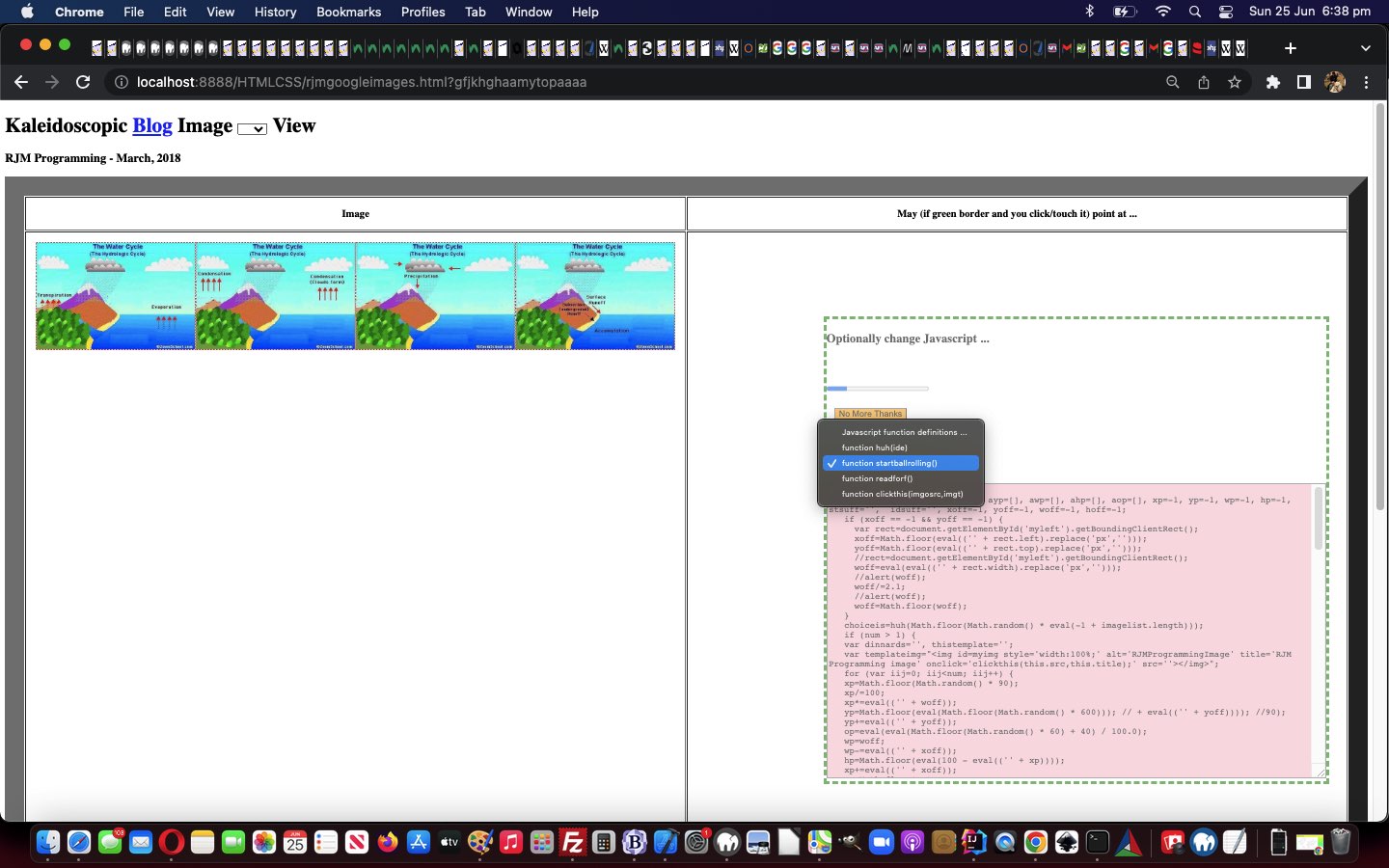We’re combining the work of two different recent tutorials, today, in our efforts to code for an external Javascript tool to allow a web application, just via the calling of this external Javascript, clientside functionality whereby the user can dynamically change (effectively override) Javascript code well after the document.body onload event’s passing …
- yesterday’s HTML Form Use of Disabled Input Elements Tutorial‘s establishment of a methodology to override Javascript functions dynamically via user interactive entry
- the recent Blog Kaleidoscopic View Detail Tutorial‘s web application, as a candidate “parent” calling our “tool” via …
<script type=text/javascript src='/fix_javascript_later.js?leftpos=60%25&toppos=30%25'></script>
… via “tool” external Javascript fix_javascript_later.js (proof of concept, first draft) code, so far, which looks like …
// fix_javascript_later.js
// RJM Programming
// June, 2023
var inithih='';
var fncodes=[], fncodenames=[''];
var fixoo=null, fixooih='', visword='hidden', vist=0, lasttvn=0;
var leftpos='calc(50% - 100px)', toppos='calc(50% - 100px)';
var lposx=(document.URL + document.head.innerHTML).split('left' + 'pos=');
var tposx=(document.URL + document.head.innerHTML).split('top' + 'pos=');
if (eval('' + lposx.length) > 1) { leftpos=decodeURIComponent(lposx[1].split('&')[0].split("'")[0].split('"')[0]); }
if (eval('' + tposx.length) > 1) { toppos=decodeURIComponent(tposx[1].split('&')[0].split("'")[0].split('"')[0]); }
function resetc() {
vist=0;
visword='hidden';
document.getElementById('dbnmt').style.visibility='visible';
document.getElementById('mypgr').value='' + vist;
}
function postscourjs(tvn) {
resetc();
lasttvn=eval('' + tvn);
if (eval('' + tvn) < 0) {
document.getElementById('djta').innerHTML='<textarea style=background-color:pink; onresize=resetc(); onchange=resetc(); onfocus=resetc(); onclick=resetc(); onblur=fix_the_js(this); id=jta>async function ' + fncodes[eval(('' + tvn).replace('-',''))].split('</script>')[0] + '</textarea>';
//alert('async function ' + fncodes[eval(('' + tvn).replace('-',''))]);
} else {
document.getElementById('djta').innerHTML='<textarea style=background-color:pink; onresize=resetc(); onchange=resetc(); onfocus=resetc(); onclick=resetc(); onblur=fix_the_js(this); id=jta>function ' + fncodes[eval(('' + tvn).replace('-',''))].split('</script>')[0] + '</textarea>';
//alert('function ' + fncodes[eval(('' + tvn).replace('-',''))]);
}
}
function scourjs() {
var ibn=0;
if (inithih == '') {
inithih=document.head.innerHTML;
fncodes=inithih.split('function ');
for (ibn=1; ibn<fncodes.length; ibn++) {
if ((fncodes[eval(-1 + ibn)].trim() + '~~').indexOf('async~~') != -1) {
fncodenames.push('async ' + fncodes[ibn].split('(')[0].trim());
} else {
fncodenames.push(fncodes[ibn].split('(')[0].trim());
}
}
if (eval('' + fncodes.length) > 1) {
fixooih='<div title="Double click to resurrect." ondblclick="putback();" id=dbnmt style="position:absolute;z-index:123;opacity:0.5;left:' + leftpos + ';top:' + toppos + ';border:5px dashed green;"><h3>Optionally change Javascript ...</h3><br><br><progress id=mypgr min=0 max=15 value=0></progress><br><br> <button id=bnmt onclick=bnmt(); style=background-color:orange;>No More Thanks</button><br><br><br><br><select style=background-color:yellow; onresize=resetc(); id=jcsel onchange=postscourjs(this.value);><option value="">Javascript function definitions ...</option></select><br><br><div id=djta><textarea style=background-color:pink; onresize=resetc(); onchange=resetc(); onfocus=resetc(); onclick=resetc(); onblur=fix_the_js(this); id=jta></textarea></div></div>';
for (ibn=1; ibn<fncodes.length; ibn++) {
if (fncodenames[ibn].trim() != fncodenames[ibn]) {
fixooih=fixooih.replace('</select>', '<option value="-' + ibn + '">async function ' + fncodes[ibn].split(')')[0] + ')</option></select>');
} else {
fixooih=fixooih.replace('</select>', '<option value=' + ibn + '>function ' + fncodes[ibn].split(')')[0] + ')</option></select>');
}
}
document.body.innerHTML+=fixooih;
fixooih=fixooih.replace('0.5','1.0');
setTimeout(vistog, 1000);
} else {
inithih='';
}
}
}
function putback() {
vist=0;
document.getElementById('dbnmt').innerHTML=fixooih;
document.getElementById('dbnmt').style.zIndex=123;
visword='hidden';
setTimeout(vistog, 1000);
}
function vistog() {
if (document.getElementById('mypgr')) {
setTimeout(vistog, 1000);
vist++;
document.getElementById('mypgr').value='' + vist;
if (vist >= 15) {
if (visword == 'hidden') {
visword='visible';
} else {
visword='hidden';
}
document.getElementById('dbnmt').style.visibility=visword;
vist=0;
}
}
}
function bnmt() {
document.getElementById('dbnmt').innerHTML='';
//document.getElementById('dbnmt').style.zIndex=-786;
}
function fix_the_js(ota) {
var tag = document.createElement('script');
tag.innerHTML = ota.value;
fncodes[lasttvn]=ota.value;
var firstScriptTag = document.getElementsByTagName('script')[eval(-1 + document.getElementsByTagName('script').length)];
firstScriptTag.insertAdjacentElement("afterend", tag);
}
setTimeout(scourjs, 5000);
… and you can see in action with the tweaked rjmgoogleimages.htm‘s adjusted web application.
As time goes on, more and more we see the benefits of URLs that start with “/” (but not HTTP:// nor HTTPS:// absolute URL designations), especially when it comes to pointing at a “tool” (eg. external Javascript). It has
the benefits of …
- is programmer controlled, so they can place the tool in Document Root folder (in the case of an Apache web server) … and, in so doing …
- it’s irrelevant where the “parent” (calling) web application is placed … and …
- mixed content issues are avoided by not using an absolute URL, though it kind of, is!
If this was interesting you may be interested in this too.



